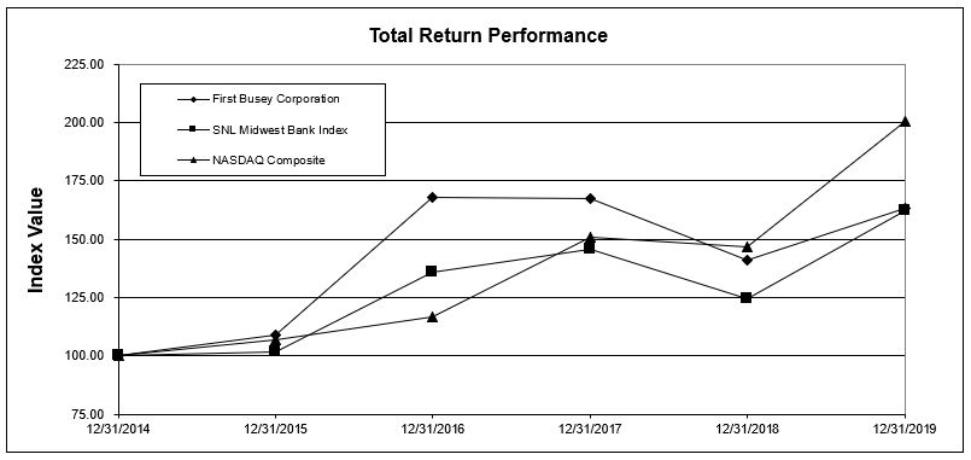Part I
Item 1. Business
Introduction
First Busey Corporation (“First Busey” or the “Company”), a Nevada corporation, initially organized in 1980, is a $9.7 billion financial holding company. First Busey conducts a broad range of financial services through its one wholly-owned bank subsidiary, Busey Bank (“the Bank”), with banking centers in Illinois, Missouri, Florida and Indiana. First Busey is headquartered in Champaign, Illinois, and its common stock is traded on The Nasdaq Global Select Market under the symbol “BUSE.”
Acquisitions
On January 8, 2015, First Busey acquired Herget Financial Corp., a Delaware corporation, and its wholly-owned bank subsidiary, Herget Bank, National Association (“Herget Bank”). First Busey operated Herget Bank as a separate banking subsidiary from January 9, 2015 until March 13, 2015, when it was merged with and into Busey Bank. At that time, Herget Bank’s banking centers became banking centers of Busey Bank.
On April 30, 2016, First Busey acquired Pulaski Financial Corp., a Missouri corporation (“Pulaski”), and its wholly-owned bank subsidiary, Pulaski Bank, National Association (“Pulaski Bank”). First Busey operated Pulaski Bank as a separate bank subsidiary from May 1, 2016 until November 4, 2016, when it was merged with and into Busey Bank. At that time, Pulaski Bank’s banking centers became banking centers of Busey Bank. The acquisition of Pulaski expanded the Company into the St. Louis, Missouri metropolitan area.
On July 2, 2017, First Busey acquired First Community Financial Partners, Inc., an Illinois corporation (“First Community”), and its wholly-owned bank subsidiary, First Community Financial Bank. First Busey operated First Community Financial Bank as a separate bank subsidiary from July 3, 2017 until November 3, 2017, when it was merged with and into Busey Bank. At that time, First Community Financial Bank’s banking centers became banking centers of Busey Bank. The First Community acquisition provided the Company entrance into the southwest suburban markets of the greater Chicagoland area.
On October 1, 2017, First Busey acquired Mid Illinois Bancorp, Inc., an Illinois corporation (“Mid Illinois”) and its wholly-owned bank subsidiary, South Side Trust & Savings Bank of Peoria (“South Side Bank”). First Busey operated South Side Bank as a separate bank subsidiary from October 2, 2017 until March 16, 2018, when it was merged with and into Busey Bank. At that time, South Side Bank’s banking centers became banking centers of Busey Bank.
On January 31, 2019, First Busey acquired The Banc Ed Corp., a Delaware corporation (“Banc Ed”) and its wholly-owned bank subsidiary, TheBANK of Edwardsville (“TheBANK”). First Busey operated TheBANK as a separate bank subsidiary from February 1, 2019 until October 4, 2019, when it was merged with and into Busey Bank. At that time, TheBANK’s banking centers became banking centers of Busey Bank.
On August 31, 2019, the Company acquired Investors’ Security Trust Company (“IST”), a Fort Myers, Florida wealth management firm.
See “Note 2. Acquisitions” in the Notes to the Consolidated Financial Statements for further information relating to acquisitions.
Subsidiaries of First Busey
First Busey conducts the business of banking, related banking services, asset management, brokerage and fiduciary services through Busey Bank and retail payment processing through FirsTech, Inc. (“FirsTech”).
Busey Bank is an Illinois state-chartered bank organized in 1868 with its headquarters in Champaign, Illinois. Busey Bank has 61 banking centers in Illinois, 13 in Missouri, five in southwest Florida and one in Indianapolis, Indiana.
